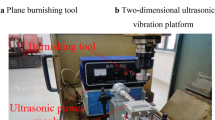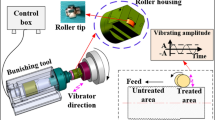Abstract
Burnishing is a way to realize surface strengthening by plastic deformation behavior. How to characterize the severe plastic deformation in subsequent burnishing process and how to make the severe plastic deformation more reasonable and effective for the improvement of machined surface integrity have become key problems. This work studied the relationships among plastic deformation behaviors, strain energy, and improved surface integrity ratio in subsequent burnishing with different initial surface conditions. To achieve this purpose, a numerical strain energy model was first established and then utilized to analyze the material flow behaviors and plastic deformation mechanism. The results indicated that the strain energy density decreases first and then increases, while the strain energy and corresponding energy efficiency gradually increases with the increase of turning feed, i.e., surface residue. As a result, the plastic deformation in subsequent burnishing first increases and then decreases with the increase of surface residue and reached the severest when the turning feed is 0.35 mm/r. Even though the turning-induced surface integrity can be further improved by the subsequent burnishing, the improved surface integrity ratio showed a downward trend with the increase of the turning feed, which ever increased the machining efficiency for the process chain. It is expected to improve both the energy efficiency ratio and improved surface integrity ratio, so as to improve the sustainability of the subsequent burnishing process.
























Similar content being viewed by others
References
Salonitis K, D’Alvise L, Schoinochoritis B, Chantzis D (2016) Additive manufacturing and post-processing simulation: laser cladding followed by high speed machining. Int J Adv Manuf Tech 85(9):2401–2411
Chew Y, Pang JHL, Bi G, Song B (2017) Effects of laser cladding on fatigue performance of AISI 4340 steel in the as-clad and machine treated conditions. J Mater Process Tech 243:246–257
Zhang P, Liu Z, Du J, Su G, Zhang J, Xu C (2020) On machinability and surface integrity in subsequent machining of additively-manufactured thick coatings: a review. J Manuf Process 53:123–143
Zhang P, Liu Z (2015) Effect of sequential turning and burnishing on the surface integrity of Cr–Ni-based stainless steel formed by laser cladding process. Surf Coat Tech 276:327–335
Zhang P, Liu Z (2017) Enhancing surface integrity and corrosion resistance of laser cladded Cr–Ni alloys by hard turning and low plasticity burnishing. Appl Surf Sci 409:169–178
Uddin M, Santifoller R, Hall C, Schlaefer T (2023) Effect of combined grinding-burnishing process on surface integrity, tribological and corrosion performance of laser-cladded Stellite 21 alloys. Adv Eng Mater 25:2201332
Anirudh PV, Kumar B, Girish G, Shailesh S, Oyyaravelu R, Kannan C, Balan ASS (2020) Effect of cryogenics-assisted low-plasticity burnishing on laser-clad Stellite 6 over SS420 substrate. J Mater Eng Perform 29(10):6861–6869
Wang J, Zhang C, Shen X, He J (2022) A study on surface integrity of laser cladding coatings post-treated by ultrasonic burnishing coupled with heat treatment. Mater Lett 308:131136
Shen X, Su H, Wang J, Zhang C, Xu C, Bai X (2021) New approach towards the machining process after laser cladding. Arch Civ Mech Eng 21(1):8
Shen X, Zhang C, Peng H, Liu C, Zhang Y (2022) Achieving high surface integrity of Fe-based laser cladding coating by optimized temperature field-assisted ultrasonic burnishing. J Manuf Process 83:270–280
Zhang C, Shen X, Wang J, Xu C, He J, Bai X (2021) Improving surface properties of Fe-based laser cladding coating deposited on a carbon steel by heat assisted ultrasonic burnishing. J Mater Res Tech 12:100–116
Zhou ZY, Zheng QY, Ding C, Yan JY, Piao ZY (2021) Effect of surface burnishing process with different strain paths on the copper microstructure. J Manuf Process 71:653–668
Teimouri R, Amini S (2019) Analytical modeling of ultrasonic surface burnishing process: evaluation of through depth localized strain. Int J Mech Sci 151:118–132
Liu Z, Yang M, Deng J, Zhang M, Dai Q (2020) A predictive approach to investigating effects of ultrasonic-assisted burnishing process on surface performances of shaft targets. Int J Adv Manuf Tech 106(9):4203–4219
Fu CH, Guo YB, McKinney J, Wei XT (2012) Process mechanics of low plasticity burnishing of nitinol alloy. J Mater Eng Perform 21:2607–2617
Zhou L, Li J, Li F, Meng Q, Li J, Xu X (2016) Energy consumption model and energy efficiency of machine tools: a comprehensive literature review. J Clean Prod 112:3721–3734
Wang B, Liu Z, Song Q, Wan Y, Shi Z (2016) Proper selection of cutting parameters and cutting tool angle to lower the specific cutting energy during high speed machining of 7050–T7451 aluminum alloy. J Clean Prod 129:292–304
Wang B, Liu Z, Song Q, Wan Y, Ren X (2020) An approach for reducing cutting energy consumption with ultra-high speed machining of super alloy Inconel 718. Int J Pr Eng Manuf-GT 7(1):35–51
Chudy R, Grzesik W (2015) Comparison of power and energy consumption for hard turning and burnishing operations of 41Cr4 steel. J Mach Eng 15:113–120
Nguyen TT, Cao LH, Nguyen TA, Dang XP (2020) Multi-response optimization of the roller burnishing process in terms of energy consumption and product quality. J Clean Prod 245:119328
Nguyen TT, Mia M (2020) Modeling and evaluation of energy efficiency of new hybrid turning-burnishing process in terms of surface properties. Energies 13(18):4929
Nguyen TT, Le MT (2021) Optimization of internal burnishing operation for energy efficiency, machined quality, and noise emission. Int J Adv Manuf Tech 114(7):2115–2139
Teimouri R, Amini S (2019) A comprehensive optimization of ultrasonic burnishing process regarding energy efficiency and workpiece quality. Surf Coat Tech 375:229–242
Terano M, Zhang F, Yoshino M (2017) Influence of burnishing condition on static recrystallization of an iron sheet. Procedia Eng 207:1850–1855
Pu Z, Yang S, Song GL, Dillon OW Jr, Puleo DA, Jawahir IS (2011) Ultrafine-grained surface layer on Mg–Al–Zn alloy produced by cryogenic burnishing for enhanced corrosion resistance. Scripta Mater 65(6):520–523
Varga G, Ferencsik V (2020) Experimental examination of surface micro-hardness improvement ratio in burnishing of external cylindrical workpieces. Cut Tool Tech Syst 93:114–121
Johnson KL (1987) Contact mechanics. Cambridge University Press
Zhang P, Liu Z (2017) On sustainable manufacturing of Cr-Ni alloy coatings by laser cladding and high-efficiency turning process chain and consequent corrosion resistance. J Clean Prod 161:676–687
Zhang P, Jin C, Jiang Q, Zhang Z (2023) Improving the surface integrity of laser cladded layer by ultrasonic-assisted burnishing at medium temperature with considering initial surface conditions. P I Mech Eng B-J Eng 237(3):452–467
Velchev S, Kolev I, Ivanov K, Gechevski S (2014) Empirical models for specific energy consumption and optimization of cutting parameters for minimizing energy consumption during turning. J Clean Prod 80:139–149
Su H, Shen X, Xu C, He J, Wang B, Su G (2020) Surface characteristics and corrosion behavior of TC11 titanium alloy strengthened by ultrasonic roller burnishing at room and medium temperature. J Mater Res Tech 9(4):8172–8185
Teimouri R, Liu Z, Wang B (2020) Analytical modeling of surface generation in ultrasonic ball burnishing including effects of indentation pile-up/sink-in and chipping fracture. Arch Civ Mech Eng 20(4):144
Chen CH, Lee CY, Ger MD, Jian SY, Hung JC, Yang PJ, Kao CH, Ferng YC, Huang YS, Jen KK (2022) The effect of oxalic acid as the pre-activator for the electropolishing of additive manufactured titanium-based materials and its characterization. Polymers-Basel 14(19):4198
Luca L, Neagu-Ventzel S, Marinescu I (2005) Effects of working parameters on surface finish in ball-burnishing of hardened steels. Precis Eng 29(2):253–256
Teimouri R, Grabowski M, Bogucki R, Slusarczyk L, Skoczypiec S (2022) Modeling of strengthening mechanisms of surface layers in burnishing process. Mater Design 223:111114
Hua Y, Liu Z, Wang B, Jiang J (2019) Residual stress regenerated on low plasticity burnished Inconel 718 surface after initial turning process. J Manuf Sci Eng 141(12):121004
Zhang P, Du J, Zhang H, Su G, Shen X, Huang W, Liu Z (2020) Effect of turning-induced initial roughness level on surface roughness and residual stress improvements in subsequent burnishing. Arch Civ Mech Eng 20:80
Charchalis A, Starosta R, Labuda W (2009) The influence of burnishing parameters on the roughness, plastic strain and shape deviations of marine pumps crankshaft pins in fresh water installations. J KONBiN 9(1):57–66
Funding
This work is financially supported by the National Natural Science Foundation of China (No. 52105455 and 52275438). This work was also supported by Basic Research Project of Pilot Project of Integration of Science, Education and Production (Qilu University of Technology (Shandong Academy of Sciences)) (No. 2023PY021 and 2022PY007).
Author information
Authors and Affiliations
Contributions
PZ: conceptualization, methodology, supervision, project administration, funding acquisition. GJ: software, investigation, formal analysis, writing—original draft. JD: conception, validation, supervision, project administration, funding acquisition. GS: conception, writing—review, and editing. YX: visualization, data curation. ZL: conceptualization, methodology.
Corresponding author
Ethics declarations
Ethical approval
This article does not contain any studies with human participants or animals performed by any of the authors.
Conflict of interest
The authors declared no competing interests.
Additional information
Publisher's Note
Springer Nature remains neutral with regard to jurisdictional claims in published maps and institutional affiliations.
Rights and permissions
Springer Nature or its licensor (e.g. a society or other partner) holds exclusive rights to this article under a publishing agreement with the author(s) or other rightsholder(s); author self-archiving of the accepted manuscript version of this article is solely governed by the terms of such publishing agreement and applicable law.
About this article
Cite this article
Zhang, P., Ji, G., Du, J. et al. On material flow behavior, strain energy, and improved surface integrity ratio in subsequent burnishing after turning. Int J Adv Manuf Technol 129, 4509–4528 (2023). https://doi.org/10.1007/s00170-023-12575-8
Received:
Accepted:
Published:
Issue Date:
DOI: https://doi.org/10.1007/s00170-023-12575-8




